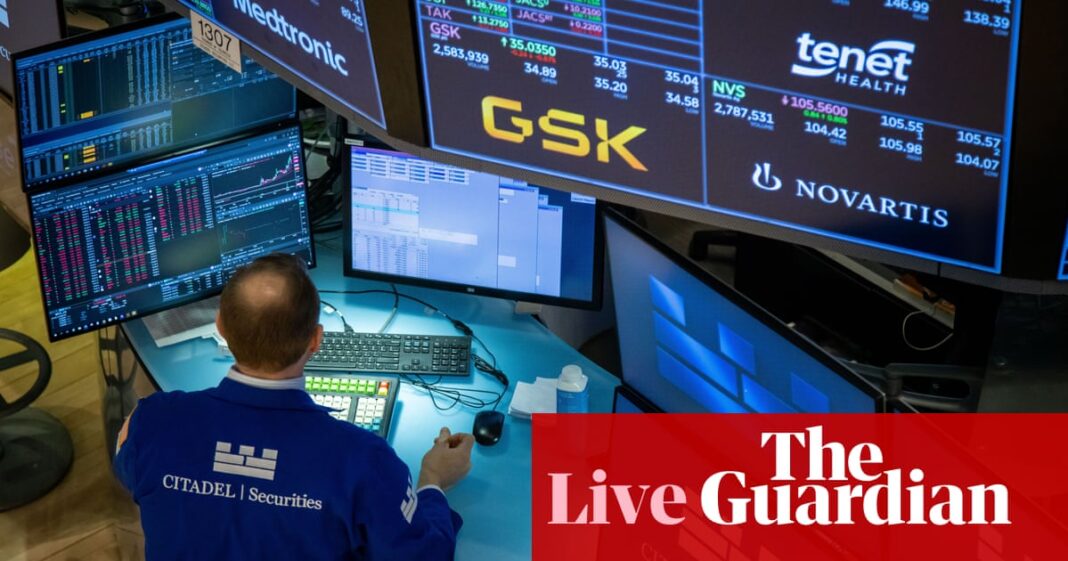Introduction: US dollar boosted by trade tensions
Good morning, and welcome to our rolling coverage of business, the financial markets and the world economy.
The US dollar is strengthening this morning, after a day of drama in the world of trade.
Overnight, the US has imposed additional 10% tariffs on Chinese imports, implementing what Donald Trump signed off last weekend – and Beijjing has hit back, with retaliatory levies on some US goods and an investigation into Google.
But after the leaders of Mexico and Canada agreed to take new measures at their borders with the US, their 25% tariffs have been delayed for a month – easing fears of a global trade war (at least for the moment).
That reverse-ferret yesterday helped to lift stock markets off their lows.
Addressing reporters in the Oval Office on Monday, Trump maintained that tariffs were a “very powerful” means of both strengthening the US economically and “getting everything else you want”.
Every country wants to agree a way to avoid US tariffs, the president claimed. “In all cases, they all wanna make deals.”
The feeling in the City is that Trump is using tariffs as a negotiating tool to push other nations into supporting his political priorities – namely border control – rather than tackling trade deficits.
Michael Brown, senior research strategist at brokerage Pepperstone, says:
In reality, tariffs appear to have little-to-nothing to do with trade agreements, or narrowing the US trade deficit, whatever pretences might be thrown around.
So while investors digest the situation – and brace for the next Trump-related newsflash – they’re seeking the safe haven of the dollar.
This morning, sterling has dropped by half a cent against the US follar to $1.24, while the euro is down a similar amount at $1.03 – putting parity in sight again.
The Canadian dollar, which slumped to a 20-year low yesterday before rebounding, has weakened again this morning too – to 1.445 to the dollar (still above Monday’s low, though).
The Mexican peso has dipped by 0.1% to 20.35/$, again higher than the three-year low hit at one stage yesterday.
The agenda
-
8am GMT: Kantar UK supermarket share data
-
3pm GMT:: US JOLTS job vaacancies report
-
3pm GMT: US factory orders for December
Key events
China has criticised the US’s decision to slap a 10% tariffs on its imports into America.
In a statement announcing retaliatory tariffs, China’s finance ministry said:
“The unilateral imposition of tariffs by the US seriously violates the rules of the World Trade Organization.
“It is not only unhelpful in solving its own problems, but also damages the normal economic and trade cooperation between China and the US.”
Those retaliatory measures by China include:
-
15% tariffs on US coal and liquefied natural gas
-
10% tariffs on crude oil, farm equipment, large-displacement vehicles and pickup trucks from the US.
-
An anti-monopoly investigation into Google
-
Adding US companies PVH Corp and Illumina to China’s “unreliable entities list”.
Asia-Pacific markets are ralling (though China’s still closed)
Asia-Pacific markets are rallying this morning, despite the trade war breaking out between China and the US.
In Hong Kong, the Hang Seng share index has jumped by almost 2.5% while South Korea’s KOSPI has jumped 1.3%.
This suggests relief that Donald Trump delayed the tariffs on Mexico and Canada yesterday, and hopes that he might reach a similar agreement when he speaks with China’s president, Xi Jinping, later this week.
Chinese markets remain closed due to the Lunar New Year holiday and will reopen tomorrow, giving traders a chance to react to the tariffs imposed by Washington DC and Beijing today.
Jim Reid, strategist at Deutsche Bank, says:
While markets are generally breathing a sigh of relief, relative to where we were over the weekend, the past few days have raised ongoing questions over Trump’s tariff policy plans. Some immediate concessions on the border issues have avoided immediate severe escalation, but Trump’s comments suggest that he will look to use the delay to leverage broader economic concessions.
Indeed, with tariffs being arguably the strongest economic tool that is almost fully at the President’s discretion, we should surely expect that these will continue to be used to both create negotiating leverage and pursue different objectives such as supply security, revenue generation and trade deficit reduction.
And some of these, notably using tariff revenue to help fund offset tax cuts, would require actual implementation of new tariffs. So there are reasons to expect lingering uncertainty in markets, and we are seeing this to some extent.
Introduction: US dollar boosted by trade tensions
Good morning, and welcome to our rolling coverage of business, the financial markets and the world economy.
The US dollar is strengthening this morning, after a day of drama in the world of trade.
Overnight, the US has imposed additional 10% tariffs on Chinese imports, implementing what Donald Trump signed off last weekend – and Beijjing has hit back, with retaliatory levies on some US goods and an investigation into Google.
But after the leaders of Mexico and Canada agreed to take new measures at their borders with the US, their 25% tariffs have been delayed for a month – easing fears of a global trade war (at least for the moment).
That reverse-ferret yesterday helped to lift stock markets off their lows.
Addressing reporters in the Oval Office on Monday, Trump maintained that tariffs were a “very powerful” means of both strengthening the US economically and “getting everything else you want”.
Every country wants to agree a way to avoid US tariffs, the president claimed. “In all cases, they all wanna make deals.”
The feeling in the City is that Trump is using tariffs as a negotiating tool to push other nations into supporting his political priorities – namely border control – rather than tackling trade deficits.
Michael Brown, senior research strategist at brokerage Pepperstone, says:
In reality, tariffs appear to have little-to-nothing to do with trade agreements, or narrowing the US trade deficit, whatever pretences might be thrown around.
So while investors digest the situation – and brace for the next Trump-related newsflash – they’re seeking the safe haven of the dollar.
This morning, sterling has dropped by half a cent against the US follar to $1.24, while the euro is down a similar amount at $1.03 – putting parity in sight again.
The Canadian dollar, which slumped to a 20-year low yesterday before rebounding, has weakened again this morning too – to 1.445 to the dollar (still above Monday’s low, though).
The Mexican peso has dipped by 0.1% to 20.35/$, again higher than the three-year low hit at one stage yesterday.
The agenda
-
8am GMT: Kantar UK supermarket share data
-
3pm GMT:: US JOLTS job vaacancies report
-
3pm GMT: US factory orders for December


